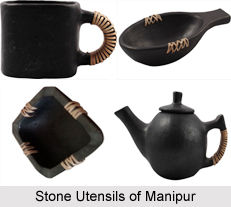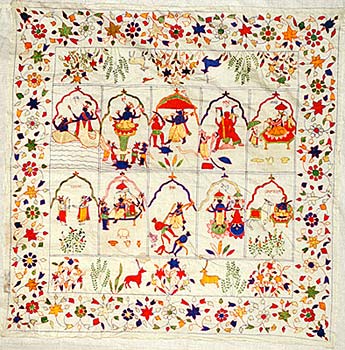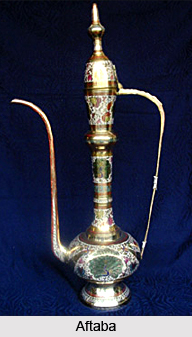 Crafts of Karnataka have passed on from one generation to the next and bear testimony to the skill, aesthetic sensibilities and decorative abilities of the craftsperson. They have received patronage from the royalty in the past. The crafts of the state include wood carving, ivory craving, kasuti embroidery, durries, pottery and cheennapatna toys. The traditional craftsmen in Karnataka uses inlaid rosewood and ebony with ivory to display their artistry. The doors of Amba Vilas Palace in Mysore and Seringapatnam mausoleum bear testimony of this form of craft. The daily use items of wood inlay include furniture such as powder boxes, bowls, puja mandaps, wall hangings, etc. The tradition of crafts in Karnataka has been religiously followed through ages.
Crafts of Karnataka have passed on from one generation to the next and bear testimony to the skill, aesthetic sensibilities and decorative abilities of the craftsperson. They have received patronage from the royalty in the past. The crafts of the state include wood carving, ivory craving, kasuti embroidery, durries, pottery and cheennapatna toys. The traditional craftsmen in Karnataka uses inlaid rosewood and ebony with ivory to display their artistry. The doors of Amba Vilas Palace in Mysore and Seringapatnam mausoleum bear testimony of this form of craft. The daily use items of wood inlay include furniture such as powder boxes, bowls, puja mandaps, wall hangings, etc. The tradition of crafts in Karnataka has been religiously followed through ages.
Traditional Crafts of Karnataka
Traditional Crafts of Karnataka are of different forms. Each region of the state has its own specialty in handicraft items that traces its origin back to the ancient rulers of South India. These crafts of Karnataka have evolved through ages to sustain` the wave of modernism and are no longer limited to the geographical borders of the state.
Wood carving in Karnataka
Wood carving is a traditional craft of Karnataka, which is done on sandalwood and rosewood. Karnataka has a vast forest reserve that provides enough raw materials for this craft. This skill requires deftness, as any form of carving should be identified when viewed from any angle. All the items are artistically and realistically sculpted. Mysore`s Gudigar or the wood carving community of Karnataka is known for the carvings on fragrant close-grained Srigandha sandalwood of Karnataka. The designs include carved flowers, creepers, birds and animals. The best of sandalwood carving reflects the unique craftsmanship of the artists. The toys of Chennapatna bear ample testimony to the artistic skill of the craftsmen. The range of traditional Chennapatna toys includes cooking vessels although today planes, trams, trucks, rattle etc. are also made.
Pottery in Karnataka
Khanpur in Belgaum district of Karnataka is known for pottery, which includes large sized containers and jars, for storing food items. The local clay is excellent and a thin variety of pottery has developed with designs embossed on it.
Weaving in Karnataka
Weaving is a household craft of Karnataka. Cotton sarees are woven in dark earthy hues with heavy maroon or chocolate colours to mark the borders. There are sarees in mat design in white or yellow; or in the rudraksh pattern. The pallu is usually in alterations of white and red hands with mounts at the two ends, woven either in cotton or silk. Irkal is a special sari of the area that is made in rich colours like pomegranate, red, peacock blue, parrot green, etc.
Embroidery in Karnataka
Further, in the world of crafts, the kasuti embroidery of Karnataka has carved a niche for itself and has been widely acclaimed by the connoisseurs of crafts all over the world. The designs of kasuti embroidery can range from architecture to cradles and animal figures. The designs have a feminine angle and are mostly done in two stitches namely, the gavanti line or double running stitch and murgi or the zigzag stitch. Kasuti is essentially used for decorating sarees and blouses and is best when done on thick materials against dark Indian shades.
Navalgund in Dharwad district of Karnataka is best known for its colourful durries. The durries are marked with intricate design and stunning colours. The designs are usually in geometrical juxtaposition. They are not only in demand within the country but outside as well. The durries are outlined in delicate floral motifs with an occasional bird or animal form added to it. A special type of durrie called sutada is made in the Bijapur district and Dharwad district. They have simple horizontal stripes in different colours. There are special designs, which lend significance to the object.
Ivory Carving in Karnataka
In the past, Ivory carving was another popular craft form of Karnataka. Ivory carving is a predominant craft practiced in the entire state of Karnataka. This art is unique and surpasses all other handicrafts of India. The ivory carving depicts mostly the images of God and Goddess. These include especially the images of Lord Krishna in various moods.
Stone Carving in Karnataka
The art of stone carving in Karnataka has been a tradition through centuries especially in Hoysala, a notable town in the state. The technique of carving is so unique and well mastered over hundreds of years that an expert of this field can identify the type of stone simply from the sound they emit when hit upon. In the present era, sculptors are most engaged in creating stone cared figures of Gods and Goddesses. The experts religiously follow the norms specified by the Dhyanashlokas while doing the stone carvings in the different villages of Karnataka.
Mysore Painting in Karnataka
This is a special type of painting that originated in Mysore during the days of the Wodeyars. Mysore paintings form a significant tradition of the classical south Indian paintings. The Mysore paintings are famous for their elegance, peculiar usage of colors and the stress on detailing. Thin gold leaves are used in the Mysore paintings. It requires tremendous hard work, patience as well as extraordinary expertise and proficiency to make a piece of Mysore painting. The Mysore paintings generally depict the images of Hindu gods and goddesses. The most notable and famous among the Mysore paintings is the depiction of the Lord Shrinath who is supposed to be the `avatar` or the incarnation of Lord Vishnu.



















